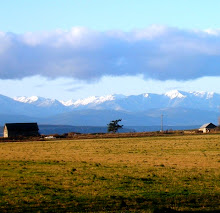

"Don't rain on my parade!" We all know the expression, but the clouds chose not to listen. The Memorial Day Parade went through downtown Coupeville on Saturday and despite the rain, many smiling spectators lined up along Main Street and Front Street to show their support for the community. The parade opened with the Northwest Junior Pipe Band and included veterans, local businesses, candidates, schools and many community groups. Memorial Day on Whidbey Island would not be complete without this long-standing tradition.
After several rainy days here at the Reserve, the sky now looks brighter and the rain has stopped. Silvery droplets still cling to the leaves of the wild roses and the bees fly among the fragrant pink flowers, stopping frequently to drink nectar from the yellow centers.

The rain hasn't stopped me from smiling and I can only imagine it has been good for the fields with their rich, chocolaty brown soil and neat rows of recently-sprouted squash leaves. In other fields, the bright yellow of the cabbage plants is already beginning to fade, reminding me that whatever the weather, the season keeps changing and summer really is on its way. Finally, the sun found a hole in the clouds and shines through the window, warm on my face, to keep me smiling for awhile longer.

Photos and post by Sierra Young














